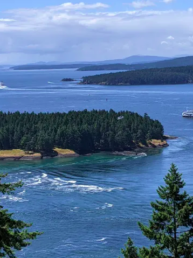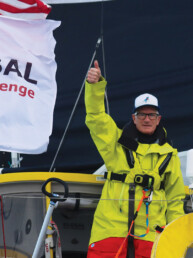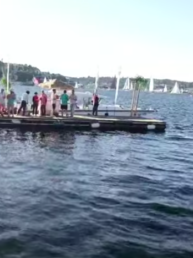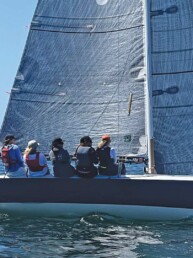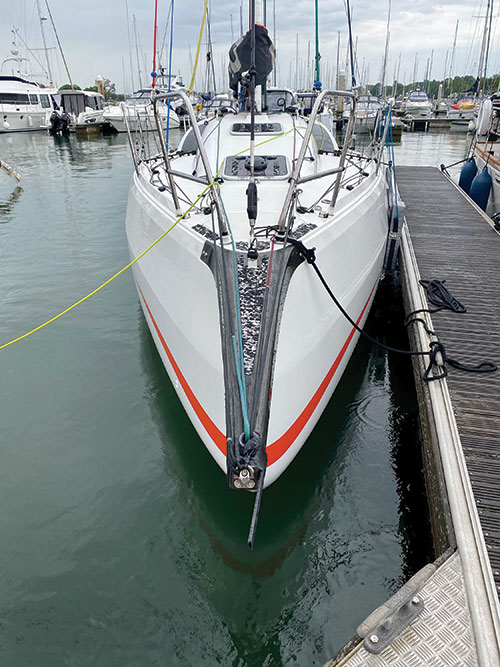
Rewind to January 2022, and Jonathan, Justin, and I are the proud owners of Red Ruby, a SunFast 3300 (SF3300) sitting in Hamble (about 75 minutes from London) on the Solent. It turns out it is easy to buy a boat abroad, but now the real work begins!
We identified two key things to address in order to be ready to race Red Ruby in May: 1) Sort out the paperwork. 2) Get the boat ready.
Oh, we learned a few lessons on the paperwork side of things. Registration? This turned out to be straightforward once we determined that US Coast Guard documentation was the best option (this also meant that the vessel would be American-flagged, which felt right, since we are all Americans). Pacific Maritime Title in Seattle made it easy, for a small fee. The biggest challenge was getting a notarized signature from the previous owner, because notaries are not a thing in the U.K.
Insurance, on the other hand, was not so easy. The insurance market has experienced a number of losses in recent years, and there are limited options for race boats nowadays, and even fewer options for a race boat in Europe with American owners. In the end, we found coverage from Edward William SL in Spain. To be honest, the premium is much higher compared to what we pay in the U.S., but it is required, and we got it done. The bright side of this search is it turns out Edward William was also the only insurer we could find to cover a boat racing to Hawaii, so we were able to spread the word to help several 2022 Pacific Cup boats obtain coverage for that race.
We also learned how to properly register Red Ruby’s VHF, AIS, and EPIRB in the U.K. — quite important not only for meeting race requirements, but also for safety.
The highlight of the next five months was getting Red Ruby prepared for the 2022 season. In hindsight, we made a few really good decisions at the outset that made this process much easier. The first thing we did right was to choose a used, but not very used, boat — which had been very well cared for. We considered getting a new boat, and are so glad we didn’t go that route. Sure, there was a small savings in buying used, but the real benefit is that most of the bugs had been worked out.
Red Ruby was launched in 2020 and setup during the pandemic by an up-and-coming young sailor, James Harayda, in partnership with well-known ocean racer, Dee Caffari. James had already marked this and added a lashing for that. He provided us with refined polars, a sail-crossover chart, and a rudder toe-in matrix (yes, that is adjustable with the push of a button) as well as detailed notes on optimizing the boat under the IRC rating system, which was novel to all of us. The sail inventory had already gone through some improvements from testing during training and races. It would have taken us years to prepare the boat to this level as intermittent visitors to the boat and region. James also agreed, as part of the purchase agreement, to move the boat to our new dry storage location and go sailing with us for two days when we arrived in May. This relationship has continued to develop, and now we are helping support James in his current racing efforts — recently he was the youngest skipper of an IMOCA 60 in the 2022 Route de Rhum.
Another thing we did right was to work with a very knowledgeable and extremely helpful broker. Nigel De Q Colley, from SeaVentures (also a SF3300 owner) bent over backwards to help us find local dry storage, coordinate on upgrades, and share insight on legal ways to avoid value-added tax (VAT) at 20%.
Lastly, we talked to a few local sailmakers and felt very good working closely with Quantum Sails’ Rory Maclean. Rory had built the original sails, and we saw eye-to-eye on where we should go from there. He would also accompany us for a sail upon our arrival in May. In the end, we upgraded just a few of the instruments and added three new sails before hitting the start line.
And then, it was May! On Tuesday, May 10, 2022, Alyosha, Jonathan, Justin, and I had just arrived in the London Heathrow airport. Our first order of business? Figure out who was going to drive a manual transmission on the left side of the road! A quick scorecard for how many times each person had previously driven on the left side of the road resulted in a 0, 0, 0, 2. Justin won that round.
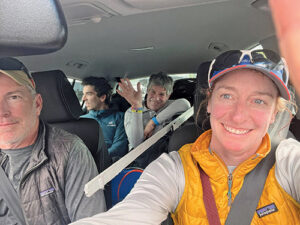
We met Red Ruby for the first time on the hard at Hamble’s Universal Marina. Sitting on a factory supplied cradle, she looked interesting to say the least. It was the first time any of us had seen an SF3300 in the flesh, and the boat is all business, sporting a very full not-quite-scow bow, twin rudders, concave hull sections in front of and behind the keel (ponder that one for a moment), no bulb on the keel, running backstays, and windows in the cabintop that face forward. Unlike many SF3300s, Red Ruby does not have water ballast. This would prove an interesting detail, since not having water ballast results in a slower IRC rating than most other SF3300s.
Our planned practice day with previous owner James dawned windy with sidewise rain — pretty much what we expected for sailing in the Solent. The breeze was a solid 20-30 knots, so naturally, we immediately threw up the A4 spinnaker and went hooning across the not-very-wide Solent, seeing 18 knots of boat speed in short order. First impressions? The boat is not slow, it is easy to drive, and very fun to sail. We couldn’t wait to get Red Ruby on the race course!
Next time, we’ll share our experience racing Red Ruby in the UK Doublehanded Offshore Series.
Feature photo by John Greene.

